Abstract
In genetic counseling, the recommended risk estimate that any heterozygous woman with myotonic dystrophy (DM) will have a congenitally affected child is 3%-9%. However, after already having had such an offspring, a DM mother's risk increases to 20%-37%. The risks of 10% and 41%, respectively, calculated in this study are similar to the estimates in the literature. However, our data on clinical status of the mothers demonstrate that only women with multisystem effects of the disorder at the time of pregnancy and delivery are likely to have congenitally affected offspring. No heterozygous woman with polychromatic lens changes but no other clinically detectable multisystem involvement had a congenitally affected child. In addition, our data suggest that the chance of having a more severely affected child increases with greater severity of maternal disease. The findings of this study are relevant for genetic counseling, as the risk of having a congenitally affected child for women with classical manifestations of the disease is shown to be higher than predicted by the overall risk estimate for any heterozygous woman. We consider it appropriate to give these classically affected women risk figures which approach the recurrence risk given to mothers with congenitally affected children. However, the risk of having a congenitally affected child for heterozygous women with no multisystem involvement appears to be minimal. Our findings support the earlier proposed hypothesis of maternal metabolites acting on a heterozygous offspring. Neither genomic imprinting nor mitochondrial inheritance is able to explain the correlation between the clinical status of heterozygous mothers and that of their children.
Full text
PDF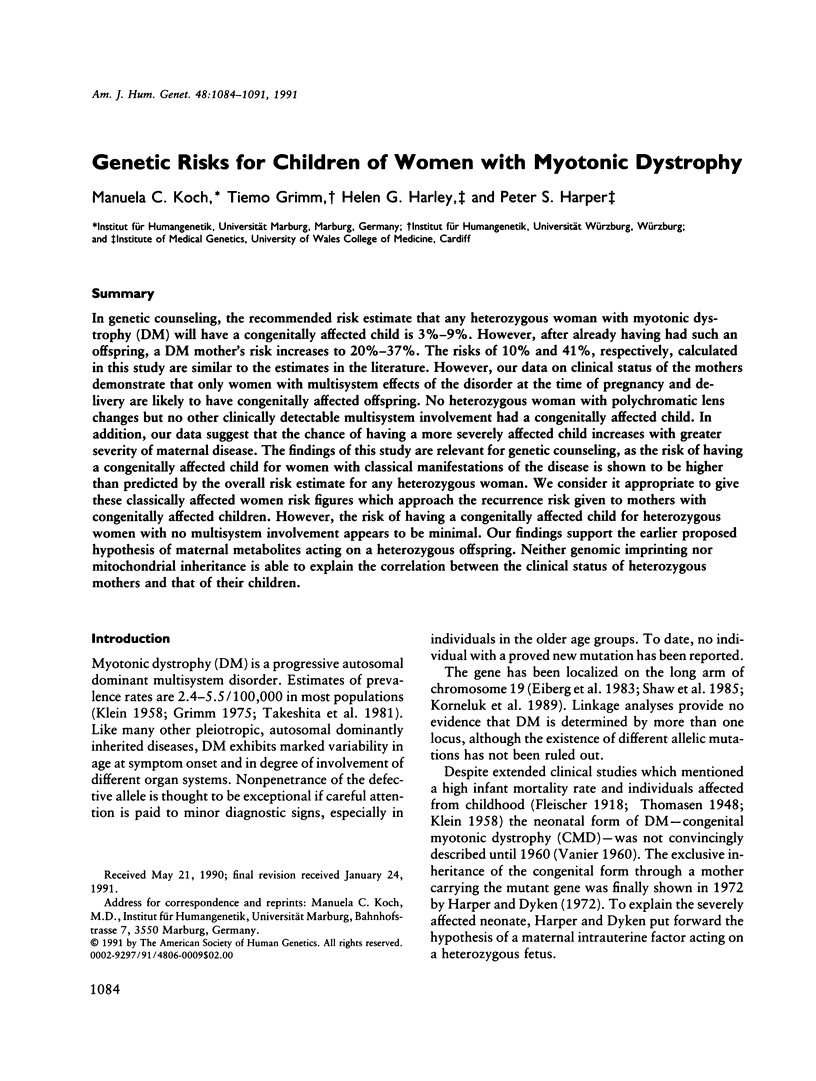
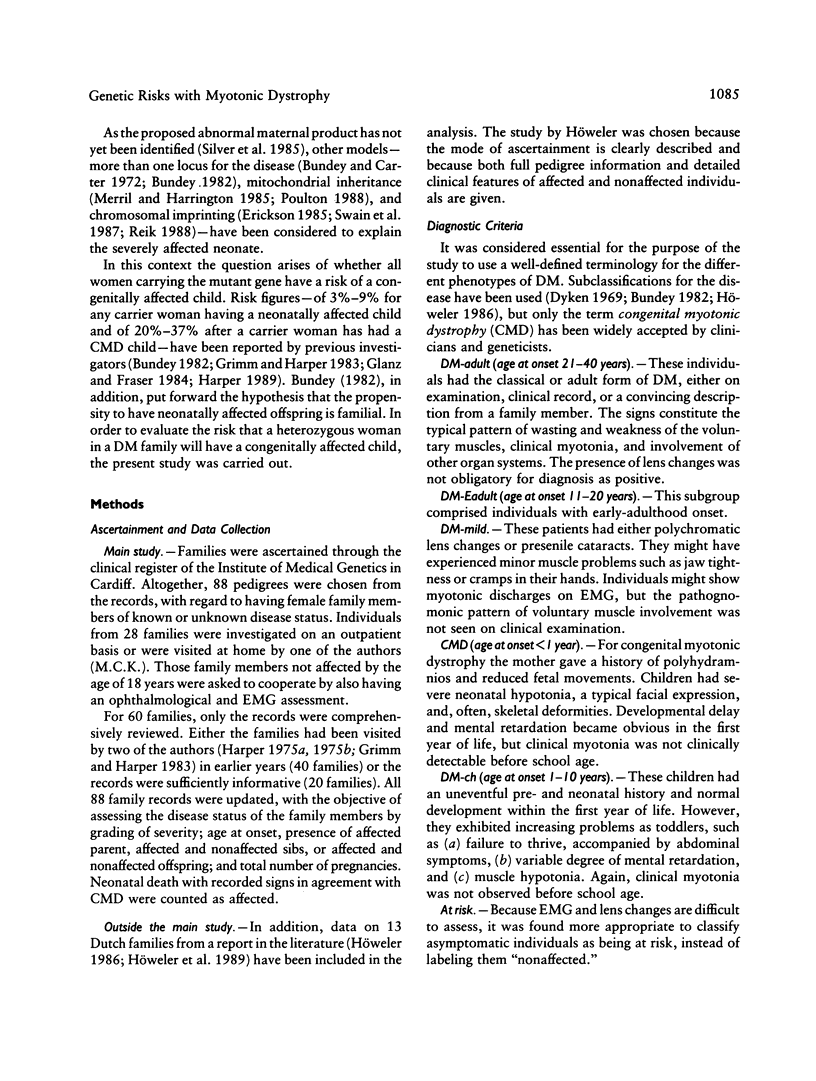
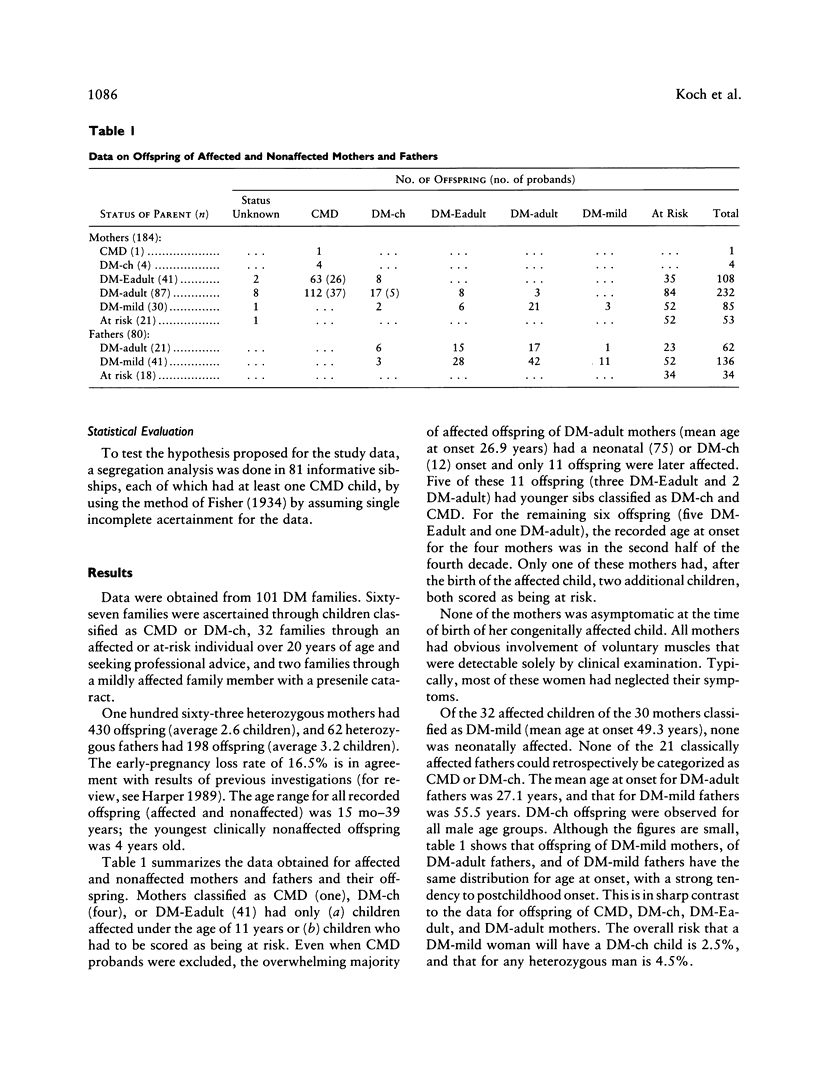
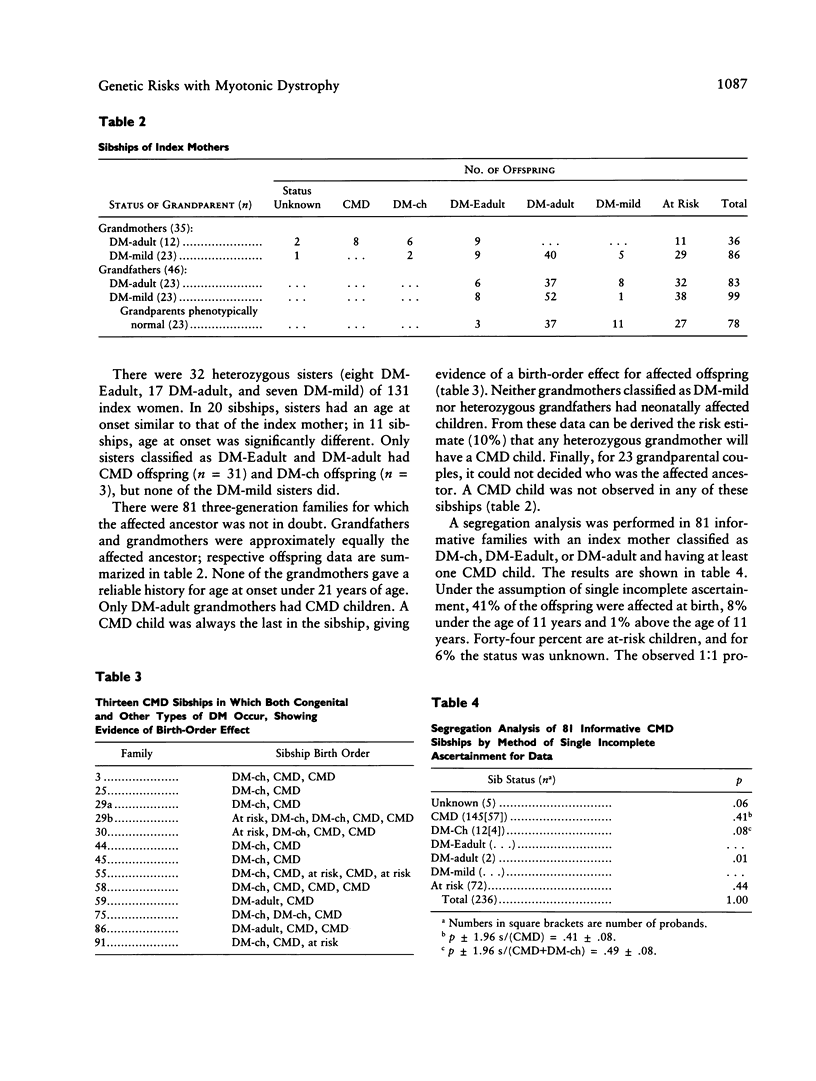
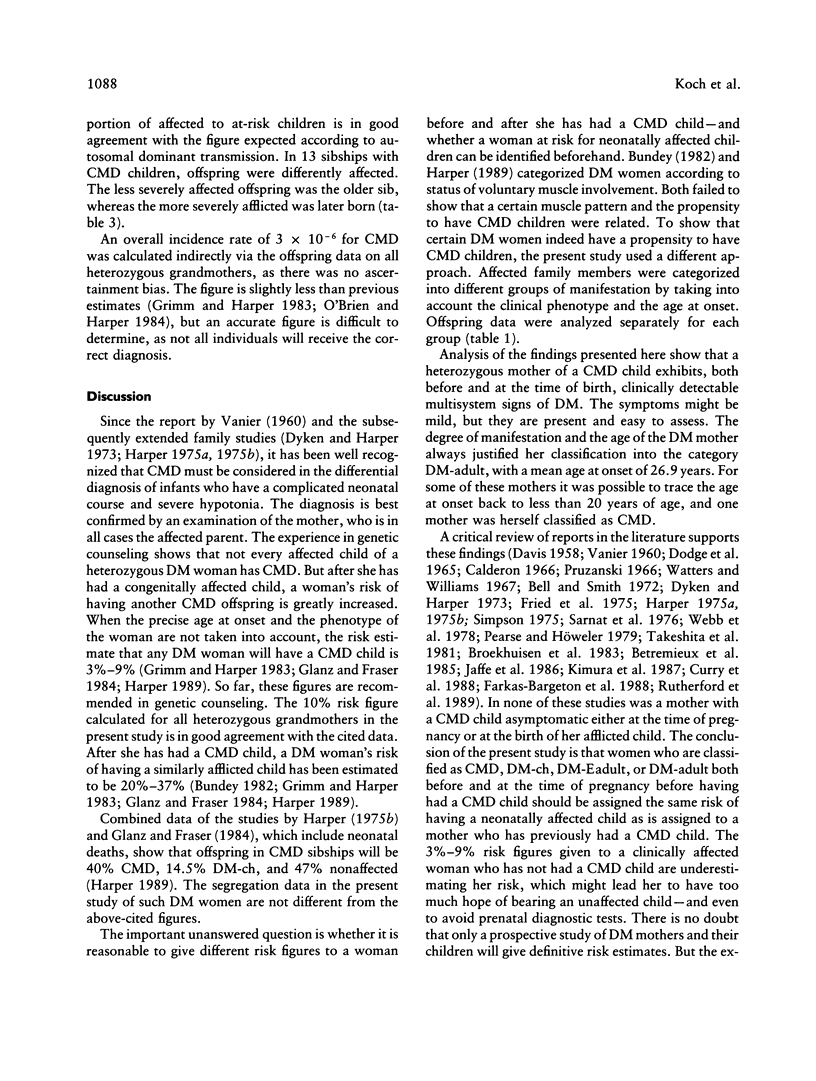
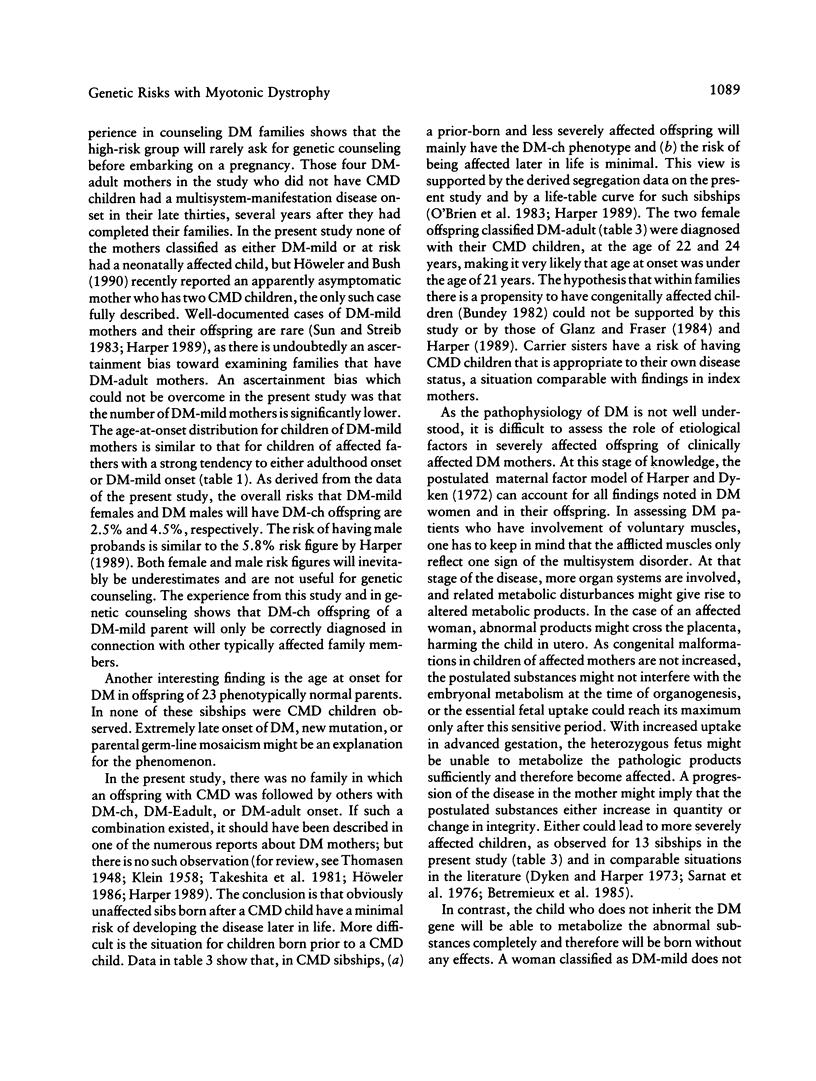
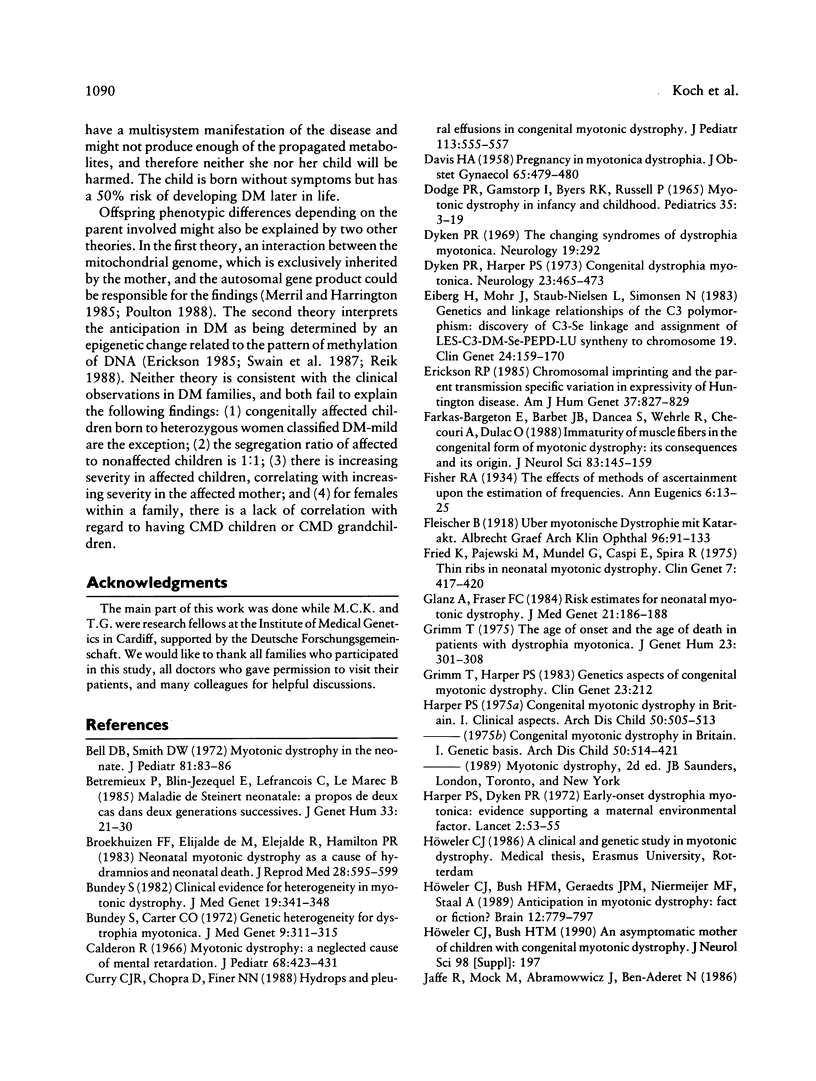
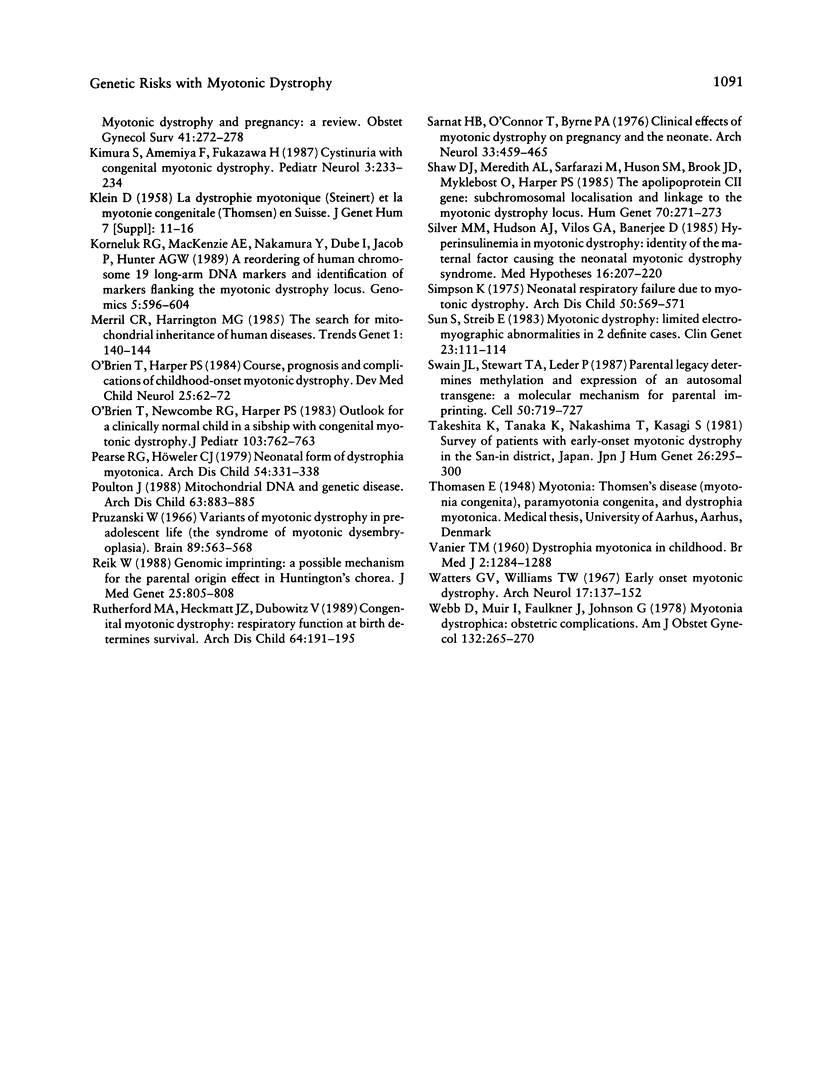
Selected References
These references are in PubMed. This may not be the complete list of references from this article.
- Bell D. B., Smith D. W. Myotonic dystrophy in the neonate. J Pediatr. 1972 Jul;81(1):83–86. doi: 10.1016/s0022-3476(72)80378-0. [DOI] [PubMed] [Google Scholar]
- Broekhuizen F. F., de Elejalde M., Elejalde R., Hamilton P. R. Neonatal myotonic dystrophy as a cause of hydramnios and neonatal death. A case report and literature review. J Reprod Med. 1983 Sep;28(9):595–599. [PubMed] [Google Scholar]
- Bundey S., Carter C. O. Genetic heterogeneity for dystrophia myotonica. J Med Genet. 1972 Sep;9(3):311–315. doi: 10.1136/jmg.9.3.311. [DOI] [PMC free article] [PubMed] [Google Scholar]
- Bundey S. Clinical evidence for heterogeneity in myotonic dystrophy. J Med Genet. 1982 Oct;19(5):341–348. doi: 10.1136/jmg.19.5.341. [DOI] [PMC free article] [PubMed] [Google Scholar]
- Bétrémieux P., Blin-Jezequel E., Lefrançois C., Le Marec B. Maladie de Steinert néonatale: à propos de deux cas dans deux générations successives. J Genet Hum. 1985 Jan;33(1):21–30. [PubMed] [Google Scholar]
- Calderon R. Myotonic dystrophy: a neglected cause of mental retardation. J Pediatr. 1966 Mar;68(3):423–431. doi: 10.1016/s0022-3476(66)80246-9. [DOI] [PubMed] [Google Scholar]
- Curry C. J., Chopra D., Finer N. N. Hydrops and pleural effusions in congenital myotonic dystrophy. J Pediatr. 1988 Sep;113(3):555–557. doi: 10.1016/s0022-3476(88)80651-6. [DOI] [PubMed] [Google Scholar]
- DAVIS H. A. Pregnancy in myotonica dystrophia; a case report. J Obstet Gynaecol Br Emp. 1958 Jun;65(3):479–480. doi: 10.1111/j.1471-0528.1958.tb08542.x. [DOI] [PubMed] [Google Scholar]
- DODGE P. R., GAMSTORP I., BYERS R. K., RUSSELL P. MYOTONIC DYSTROPHY IN INFANCY AND CHILDHOOD. Pediatrics. 1965 Jan;35:3–19. [PubMed] [Google Scholar]
- Dyken P. R., Harper P. S. Congenital dystrophia myotonica. Neurology. 1973 May;23(5):465–473. doi: 10.1212/wnl.23.5.465. [DOI] [PubMed] [Google Scholar]
- Eiberg H., Mohr J., Nielsen L. S., Simonsen N. Genetics and linkage relationships of the C3 polymorphism: discovery of C3-Se linkage and assignment of LES-C3-DM-Se-PEPD-Lu synteny to chromosome 19. Clin Genet. 1983 Sep;24(3):159–170. doi: 10.1111/j.1399-0004.1983.tb02233.x. [DOI] [PubMed] [Google Scholar]
- Erickson R. P. Chromosomal imprinting and the parent transmission specific variation in expressivity of Huntington disease. Am J Hum Genet. 1985 Jul;37(4):827–829. [PMC free article] [PubMed] [Google Scholar]
- Farkas-Bargeton E., Barbet J. P., Dancea S., Wehrle R., Checouri A., Dulac O. Immaturity of muscle fibers in the congenital form of myotonic dystrophy: its consequences and its origin. J Neurol Sci. 1988 Feb;83(2-3):145–159. doi: 10.1016/0022-510x(88)90064-0. [DOI] [PubMed] [Google Scholar]
- Fried K., Pajewski M., Mundel G., Caspi E., Spira R. Thin ribs in neonatal myotonic dystrophy. Clin Genet. 1975 May-Jun;7(5):417–420. doi: 10.1111/j.1399-0004.1975.tb00351.x. [DOI] [PubMed] [Google Scholar]
- Glånz A., Fråser F. C. Risk estimates for neonatal myotonic dystrophy. J Med Genet. 1984 Jun;21(3):186–188. [PMC free article] [PubMed] [Google Scholar]
- Harper P. S. Congenital myotonic dystrophy in Britain. I. Clinical aspects. Arch Dis Child. 1975 Jul;50(7):505–513. doi: 10.1136/adc.50.7.505. [DOI] [PMC free article] [PubMed] [Google Scholar]
- Harper P. S., Dyken P. R. Early-onset dystrophia myotonica. Evidence supporting a maternal environmental factor. Lancet. 1972 Jul 8;2(7767):53–55. doi: 10.1016/s0140-6736(72)91548-6. [DOI] [PubMed] [Google Scholar]
- Jaffe R., Mock M., Abramowicz J., Ben-Aderet N. Myotonic dystrophy and pregnancy: a review. Obstet Gynecol Surv. 1986 May;41(5):272–278. doi: 10.1097/00006254-198605000-00003. [DOI] [PubMed] [Google Scholar]
- Kimura S., Amemiya F., Fukazawa H. Cystinuria with congenital myotonic dystrophy. Pediatr Neurol. 1987 Jul-Aug;3(4):233–234. doi: 10.1016/0887-8994(87)90025-7. [DOI] [PubMed] [Google Scholar]
- Korneluk R. G., MacKenzie A. E., Nakamura Y., Dubé I., Jacob P., Hunter A. G. A reordering of human chromosome 19 long-arm DNA markers and identification of markers flanking the myotonic dystrophy locus. Genomics. 1989 Oct;5(3):596–604. doi: 10.1016/0888-7543(89)90028-1. [DOI] [PubMed] [Google Scholar]
- O'Brien T. A., Harper P. S. Course, prognosis and complications of childhood-onset myotonic dystrophy. Dev Med Child Neurol. 1984 Feb;26(1):62–67. doi: 10.1111/j.1469-8749.1984.tb04407.x. [DOI] [PubMed] [Google Scholar]
- O'Brien T., Newcombe R. G., Harper P. S. Outlook for a clinically normal child in a sibship with congenital myotonic dystrophy. J Pediatr. 1983 Nov;103(5):762–763. doi: 10.1016/s0022-3476(83)80480-6. [DOI] [PubMed] [Google Scholar]
- Pearse R. G., Höweler C. J. Neonatal form of dystrophia myotonica. Five cases in preterm babies and a review of earlier reports. Arch Dis Child. 1979 May;54(5):331–338. doi: 10.1136/adc.54.5.331. [DOI] [PMC free article] [PubMed] [Google Scholar]
- Poulton J. Mitochondrial DNA and genetic disease. Arch Dis Child. 1988 Aug;63(8):883–885. doi: 10.1136/adc.63.8.883. [DOI] [PMC free article] [PubMed] [Google Scholar]
- Pruzanski W. Variants of myotonic dystrophy in pre-adolescent life (the syndrome of myotonic dysembryoplasia). Brain. 1966 Sep;89(3):563–568. doi: 10.1093/brain/89.3.563. [DOI] [PubMed] [Google Scholar]
- Reik W. Genomic imprinting: a possible mechanism for the parental origin effect in Huntington's chorea. J Med Genet. 1988 Dec;25(12):805–808. doi: 10.1136/jmg.25.12.805. [DOI] [PMC free article] [PubMed] [Google Scholar]
- Rutherford M. A., Heckmatt J. Z., Dubowitz V. Congenital myotonic dystrophy: respiratory function at birth determines survival. Arch Dis Child. 1989 Feb;64(2):191–195. doi: 10.1136/adc.64.2.191. [DOI] [PMC free article] [PubMed] [Google Scholar]
- Sarnat H. B., O'Connor T., Byrne P. A. Clinical effects of myotonic dystrophy on pregnancy and the neonate. Arch Neurol. 1976 Jul;33(7):459–465. doi: 10.1001/archneur.1976.00500070001001. [DOI] [PubMed] [Google Scholar]
- Shaw D. J., Meredith A. L., Sarfarazi M., Huson S. M., Brook J. D., Myklebost O., Harper P. S. The apolipoprotein CII gene: subchromosomal localisation and linkage to the myotonic dystrophy locus. Hum Genet. 1985;70(3):271–273. doi: 10.1007/BF00273455. [DOI] [PubMed] [Google Scholar]
- Silver M. M., Hudson A. J., Vilos G. A., Banerjee D. Hyperinsulinemia in myotonic dystrophy: identity of the maternal factor causing the neonatal myotonic dystrophy syndrome. Med Hypotheses. 1985 Mar;16(3):207–220. doi: 10.1016/0306-9877(85)90002-7. [DOI] [PubMed] [Google Scholar]
- Simpson K. Neonatal respiratory failure due to myotonic dystrophy. Arch Dis Child. 1975 Jul;50(7):569–571. doi: 10.1136/adc.50.7.569. [DOI] [PMC free article] [PubMed] [Google Scholar]
- Sun S. F., Streib E. W. Myotonic dystrophy: limited electromyographic abnormalities in 2 definite cases. Clin Genet. 1983 Feb;23(2):111–114. [PubMed] [Google Scholar]
- Swain J. L., Stewart T. A., Leder P. Parental legacy determines methylation and expression of an autosomal transgene: a molecular mechanism for parental imprinting. Cell. 1987 Aug 28;50(5):719–727. doi: 10.1016/0092-8674(87)90330-8. [DOI] [PubMed] [Google Scholar]
- Takeshita K., Tanaka K., Nakashima T., Kasagi S. Survey of patients with early-onset myotonic dystrophy in the San-In district, Japan. Jinrui Idengaku Zasshi. 1981 Dec;26(4):295–300. doi: 10.1007/BF01876360. [DOI] [PubMed] [Google Scholar]
- Watters G. V., Williams T. W. Early onset myotonic dystrophy. Clinical and laboratory findings in five families and a review of the literature. Arch Neurol. 1967 Aug;17(2):137–152. doi: 10.1001/archneur.1967.00470260027003. [DOI] [PubMed] [Google Scholar]
- Webb D., Muir I., Faulkner J., Johnson G. Myotonia dystrophica: obstetric complications. Am J Obstet Gynecol. 1978 Oct 1;132(3):265–270. doi: 10.1016/0002-9378(78)90891-8. [DOI] [PubMed] [Google Scholar]


